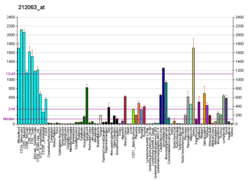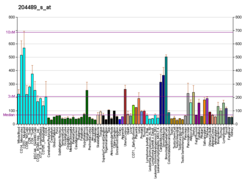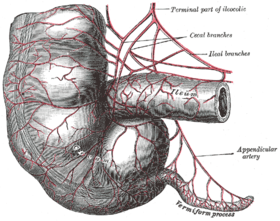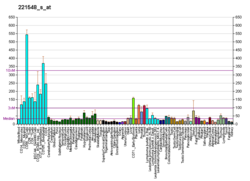CD44
CD44CD44 항원은 세포-세포 상호작용, 세포 접착 및 이동에 관여하는 세포 표면 당단백질이다.인간의 경우 CD44 항원은 11번 [5]염색체의 CD44 유전자에 의해 암호화되며, CD44는 HCAM(호밍 세포 접착 분자), Pgp-1(식세포 당단백질-1), 헤르메스 항원, 림프구 호밍 수용체, ECM-III 및 HUTCH-1로 언급되어 왔다.
조직 분포 및 Isoforms
CD44는 다수의 포유동물 세포형으로 발현된다.exon 1-5와 16-20으로 구성된 CD44로 지정된 표준 등소형은 대부분의 세포 유형에서 발현된다.가변 엑손이 포함된 CD44 스플라이스 변종은 CD44v로 지정된다. 일부 상피 세포는 엑손 v8–10을 [6]포함하는 더 큰 아이소폼(CD44E)을 발현한다.
기능.
CD44는 림프구 활성화, 재순환 및 호밍, 조혈 및 종양 전이를 포함한 광범위한 세포 기능에 관여한다.
CD44는 히알루론산에 대한 수용체이며, 또한 오스테오폰틴, 콜라겐, 매트릭스 메탈로프로테아제(MMPs)와 같은 다른 리간드와 상호작용할 수 있다.CD44 기능은 번역 후 수정에 의해 제어됩니다.하나의 중요한 변형은 HCELL이라고 불리는 CD44의 셀렉틴 결합 당 형태를 렌더링하는 이산 시알로푸코실화를 포함한다(조혈세포 E-셀렉틴/L-셀렉틴 리간드의 [7]경우).(아래 참조)
이 유전자의 전사물은 많은 기능적으로 구별되는 등소형태를 낳는 복잡한 대체 스플라이싱을 거친다. 그러나, 이러한 변종들 중 일부의 전체 길이의 성질은 결정되지 않았다.대체 스플라이싱은 이 단백질의 구조적, 기능적 다양성의 기초이며 종양 전이와 관련이 있을 수 있다.대장암세포에서 CD44의 스플라이스 변이체는 [8][9]암 전이 과정과 관련된 혈류 조건 하에서 피브리노겐이 아닌 P-, L-, E-셀렉틴 리간드로 기능하는 시알로푸코실화 HCELL 당화 형태를 나타낸다.
CD44 유전자 전사는 적어도 부분적으로 베타-카테닌과 Wnt 시그널링에 의해 활성화된다(종양의 발달과도 관련이 있다).
H셀
HCELL 당질은 원래 인간의 조혈모세포와 백혈병 발작에서 발견되었고,[7][10][11][12] 이후 암세포에서 [9][13][14][15][16]확인되었다.HCELL은 "뼈 호밍 수용체"로서 기능하여 인간 조혈 줄기세포와 간엽 줄기세포의 [11]골수로의 이동을 지시한다.살아있는 세포 표면의 생체외 글리칸 공학은 CD44를 [17]발현하는 세포에 HCELL 발현을 강제하기 위해 사용되어 왔다. CD44 글리코실화는 또한 섬유소 및 고정화된 [8][18]피브리노겐에 대한 결합 능력을 직접적으로 제어한다.
임상적 의의
그 단백질은 인도 혈액형 시스템을 결정하는 요인이다.
- CD44는 CD25와 함께 흉선의 초기 T세포 발달을 추적하는데 사용된다.
- CD44 표현은 이펙터 메모리 T셀의 지표 마커입니다.기억세포의 증식(활성화)은 CFSE 화학적 태깅을 사용하여 체외에서 측정할 수도 있다.
또한 CD44의 변화는 일부 유방암 및 전립선암 줄기세포의 세포 표면 마커로 보고된다.유방암 연구에서 CD44+/CD24- 표현은 일반적으로 유방암 CSC의 지표로 사용되며, 줄기세포와 유사한 특성을[19] 가진 세포에서 풍부한 모집단으로 유방암 세포를 분류하는 데 사용되며, 상피 난소암 [20]환자의 생존 시간 증가의 지표로 보여져 왔다.
자궁내막증이 있는 여성의 자궁내막세포는 CD44의 스플라이스 변이체의 발현 증가와 복막세포 [21]부착의 증가를 보여준다.
CD44 변종 동질세포는 머리와 목의 편평상피암의 [22][23]진행과도 관련이 있다.
CD44 변종에 대한 모노클로널 항체는 v6용 비바투주맙을 포함한다.
암의 CD44
CD44는 세포증식, 세포분화, 세포이동, 혈관신생, 대응하는 수용체에 대한 사이토카인, 케모카인 및 성장인자의 제시, 세포막에서의 단백질 분해효소 도킹 및 세포생존 시그널링에 관여하는 다구조 및 다기능 세포표면분자이다.이러한 모든 생물학적 특성은 정상 세포의 생리 활동에 필수적이지만, 그것들은 암 세포의 병리학적 활동과도 관련이 있습니다.동물 실험을 통해 항체, 안티센스 올리고뉴클레오티드 및 CD44 수용성 단백질에 의한 CD44의 표적화(targeting)가 다양한 신생물들의 악성 활성을 현저하게 감소시켜 항CD44제의 치료 가능성을 강조했다.
백혈병 [24]발생에는 백혈병 세포에서 높은 수준의 접착 분자 CD44가 필수적이다.또한 대체 스플라이싱 및 번역 후 수정은 종양 특이 배열을 포함한 많은 다른 CD44 배열을 생성하기 때문에 항CD44 종양 특이 배열을 생성하는 것이 현실적인 [25]치료 방법일 수 있다.
많은 암(신장암과 비호지킨 림프종은 예외)에서 CD44 발현 수치가 항상 좋지 않은 [26]결과와 관련이 있는 것은 아니다.반대로 일부 신플라즘 CD44의 업 레귤레이션은 양호한 결과와 관련되어 있다.이는 전립선암에 해당하며, 전치사 변형 CD44v5(5번째 'v5' 엑손 포함)는 더 나은 예후(수술 [27][26]후 재발까지의 시간 증가)와 관련이 있다.전립선암에서 대체 스플라이싱을 통한 v5 엑손의 배제는 RNA 결합 단백질 KHDRBS1의 존재와 관련이 있었으며 YTHDC1 또는 메타데린 [27]발현 증가에 포함되었다.
다른 경우에는 동일한 종양 질환을 분석하는 다른 연구 그룹이 CD44 발현과 질병 예후 사이의 상관관계에 대해 상반된 결론에 도달했는데, 이는 아마도 방법론의 차이 때문일 것이다.이러한 문제들은 인간 [26]암에 항CD44 치료를 적용하기 전에 반드시 해결되어야 한다.
상호 작용
CD44는 다음 제품과 상호 작용하는 것으로 나타났습니다.
레퍼런스
- ^ a b c GRCh38: 앙상블 릴리즈 89: ENSG000026508 - 앙상블, 2017년 5월
- ^ a b c GRCm38: 앙상블 릴리즈 89: ENSMUSG00000005087 - 앙상블, 2017년 5월
- ^ "Human PubMed Reference:". National Center for Biotechnology Information, U.S. National Library of Medicine.
- ^ "Mouse PubMed Reference:". National Center for Biotechnology Information, U.S. National Library of Medicine.
- ^ Spring FA, Dalchau R, Daniels GL, Mallinson G, Judson PA, Parsons SF, Fabre JW, Anstee DJ (May 1988). "The Ina and Inb blood group antigens are located on a glycoprotein of 80,000 MW (the CDw44 glycoprotein) whose expression is influenced by the In(Lu) gene". Immunology. 64 (1): 37–43. PMC 1385183. PMID 2454887.
- ^ Goodison S, Urquidi V, Tarin D (Aug 1999). "CD44 cell adhesion molecules". Molecular Pathology. 52 (4): 189–96. doi:10.1136/mp.52.4.189. PMC 395698. PMID 10694938.
- ^ a b Oxley SM, Sackstein R (Nov 1994). "Detection of an L-selectin ligand on a hematopoietic progenitor cell line". Blood. 84 (10): 3299–306. doi:10.1182/blood.V84.10.3299.3299. PMID 7524735.
- ^ a b c Alves CS, Burdick MM, Thomas SN, Pawar P, Konstantopoulos K (Apr 2008). "The dual role of CD44 as a functional P-selectin ligand and fibrin receptor in colon carcinoma cell adhesion". American Journal of Physiology. Cell Physiology. 294 (4): C907–16. doi:10.1152/ajpcell.00463.2007. PMID 18234849.
- ^ a b Hanley WD, Burdick MM, Konstantopoulos K, Sackstein R (Jul 2005). "CD44 on LS174T colon carcinoma cells possesses E-selectin ligand activity". Cancer Research. 65 (13): 5812–7. doi:10.1158/0008-5472.CAN-04-4557. PMID 15994957.
- ^ Sackstein R, Dimitroff CJ (Oct 2000). "A hematopoietic cell L-selectin ligand that is distinct from PSGL-1 and displays N-glycan-dependent binding activity". Blood. 96 (8): 2765–74. doi:10.1182/blood.V96.8.2765. PMID 11023510.
- ^ a b Sackstein R, Merzaban JS, Cain DW, Dagia NM, Spencer JA, Lin CP, Wohlgemuth R (Feb 2008). "Ex vivo glycan engineering of CD44 programs human multipotent mesenchymal stromal cell trafficking to bone". Nature Medicine. 14 (2): 181–7. doi:10.1038/nm1703. PMID 18193058. S2CID 5095656.
- ^ Dimitroff CJ, Lee JY, Rafii S, Fuhlbrigge RC, Sackstein R (Jun 2001). "CD44 is a major E-selectin ligand on human hematopoietic progenitor cells". The Journal of Cell Biology. 153 (6): 1277–86. doi:10.1083/jcb.153.6.1277. PMC 2192031. PMID 11402070.
- ^ Burdick MM, Chu JT, Godar S, Sackstein R (May 2006). "HCELL is the major E- and L-selectin ligand expressed on LS174T colon carcinoma cells". The Journal of Biological Chemistry. 281 (20): 13899–905. doi:10.1074/jbc.M513617200. PMID 16565092.
- ^ a b Hanley WD, Napier SL, Burdick MM, Schnaar RL, Sackstein R, Konstantopoulos K (Feb 2006). "Variant isoforms of CD44 are P- and L-selectin ligands on colon carcinoma cells". FASEB Journal. 20 (2): 337–9. doi:10.1096/fj.05-4574fje. PMID 16352650. S2CID 23662591.
- ^ a b Napier SL, Healy ZR, Schnaar RL, Konstantopoulos K (Feb 2007). "Selectin ligand expression regulates the initial vascular interactions of colon carcinoma cells: the roles of CD44v and alternative sialofucosylated selectin ligands". The Journal of Biological Chemistry. 282 (6): 3433–41. doi:10.1074/jbc.M607219200. PMID 17135256.
- ^ a b Thomas SN, Zhu F, Schnaar RL, Alves CS, Konstantopoulos K (Jun 2008). "Carcinoembryonic antigen and CD44 variant isoforms cooperate to mediate colon carcinoma cell adhesion to E- and L-selectin in shear flow". The Journal of Biological Chemistry. 283 (23): 15647–55. doi:10.1074/jbc.M800543200. PMC 2414264. PMID 18375392.
- ^ Sackstein R (Jul 2009). "Glycosyltransferase-programmed stereosubstitution (GPS) to create HCELL: engineering a roadmap for cell migration". Immunological Reviews. 230 (1): 51–74. doi:10.1111/j.1600-065X.2009.00792.x. PMC 4306344. PMID 19594629.
- ^ a b Alves CS, Yakovlev S, Medved L, Konstantopoulos K (Jan 2009). "Biomolecular characterization of CD44-fibrin(ogen) binding: distinct molecular requirements mediate binding of standard and variant isoforms of CD44 to immobilized fibrin(ogen)". The Journal of Biological Chemistry. 284 (2): 1177–89. doi:10.1074/jbc.M805144200. PMC 2613610. PMID 19004834.
- ^ Li F, Tiede B, Massagué J, Kang Y (Jan 2007). "Beyond tumorigenesis: cancer stem cells in metastasis". Cell Research. 17 (1): 3–14. doi:10.1038/sj.cr.7310118. PMID 17179981.
- ^ Sillanpää S, Anttila MA, Voutilainen K, Tammi RH, Tammi MI, Saarikoski SV, Kosma VM (Nov 2003). "CD44 expression indicates favorable prognosis in epithelial ovarian cancer". Clinical Cancer Research. 9 (14): 5318–24. PMID 14614016.
- ^ Griffith JS, Liu YG, Tekmal RR, Binkley PA, Holden AE, Schenken RS (Apr 2010). "Menstrual endometrial cells from women with endometriosis demonstrate increased adherence to peritoneal cells and increased expression of CD44 splice variants". Fertility and Sterility. 93 (6): 1745–9. doi:10.1016/j.fertnstert.2008.12.012. PMC 2864724. PMID 19200980.
- ^ Wang SJ, Wong G, de Heer AM, Xia W, Bourguignon LY (Aug 2009). "CD44 variant isoforms in head and neck squamous cell carcinoma progression". The Laryngoscope. 119 (8): 1518–30. doi:10.1002/lary.20506. PMC 2718060. PMID 19507218.
- ^ Assimakopoulos D, Kolettas E, Patrikakos G, Evangelou A (Oct 2002). "The role of CD44 in the development and prognosis of head and neck squamous cell carcinomas". Histology and Histopathology. 17 (4): 1269–81. PMID 12371152.
- ^ Quere R, Andradottir S, Brun A, Zubarev R, Karlsson G, Olsson K, Magnusson M, Cammenga J, Karlsson S (Mar 2010). "High levels of the adhesion molecule CD44 on leukemic cells generate acute myeloid leukemia relapse after withdrawal of the initial transforming event". Leukemia. 25 (3): 515–526. doi:10.1038/leu.2010.281. PMC 3072510. PMID 21116281.
- ^ Eibl RH, Pietsch T, Moll J, Skroch-Angel P, Heider KH, von Ammon K, Wiestler OD, Ponta H, Kleihues P, Herrlich P (Dec 1995). "Expression of variant CD44 epitopes in human astrocytic brain tumors". Journal of Neuro-Oncology. 26 (3): 165–70. doi:10.1007/bf01052619. PMID 8750182. S2CID 21251441.
- ^ a b c Naor D, Nedvetzki S, Golan I, Melnik L, Faitelson Y (Nov 2002). "CD44 in cancer". Critical Reviews in Clinical Laboratory Sciences. 39 (6): 527–79. doi:10.1080/10408360290795574. PMID 12484499. S2CID 30019668.
- ^ a b Luxton HJ, Simpson BS, Mills IG, Brindle NR, Ahmed Z, Stavrinides V, et al. (August 2019). "The Oncogene Metadherin Interacts with the Known Splicing Proteins YTHDC1, Sam68 and T-STAR and Plays a Novel Role in Alternative mRNA Splicing". Cancers. 11 (9): 1233. doi:10.3390/cancers11091233. PMC 6770463. PMID 31450747.
- ^ Bourguignon LY, Singleton PA, Zhu H, Diedrich F (Aug 2003). "Hyaluronan-mediated CD44 interaction with RhoGEF and Rho kinase promotes Grb2-associated binder-1 phosphorylation and phosphatidylinositol 3-kinase signaling leading to cytokine (macrophage-colony stimulating factor) production and breast tumor progression". The Journal of Biological Chemistry. 278 (32): 29420–34. doi:10.1074/jbc.M301885200. PMID 12748184.
- ^ Chen X, Khajeh JA, Ju JH, Gupta YK, Stanley CB, Do C, Heller WT, Aggarwal AK, Callaway DJ, Bu Z (Mar 2015). "Phosphatidylinositol 4,5-bisphosphate clusters the cell adhesion molecule CD44 and assembles a specific CD44-Ezrin heterocomplex, as revealed by small angle neutron scattering". The Journal of Biological Chemistry. 290 (10): 6639–52. doi:10.1074/jbc.M114.589523. PMC 4358296. PMID 25572402.
- ^ Midgley AC, Rogers M, Hallett MB, Clayton A, Bowen T, Phillips AO, Steadman R (May 2013). "TGF-β1-stimulated fibroblast to myofibroblast differentiation is mediated by HA-facilitated EGFR and CD44 co-localization in lipid rafts". The Journal of Biological Chemistry. 288 (21): 14824–38. doi:10.1074/jbc.M113.451336. PMC 3663506. PMID 23589287.
- ^ Jalkanen S, Jalkanen M (Feb 1992). "Lymphocyte CD44 binds the COOH-terminal heparin-binding domain of fibronectin". The Journal of Cell Biology. 116 (3): 817–25. doi:10.1083/jcb.116.3.817. PMC 2289325. PMID 1730778.
- ^ a b Ilangumaran S, Briol A, Hoessli DC (May 1998). "CD44 selectively associates with active Src family protein tyrosine kinases Lck and Fyn in glycosphingolipid-rich plasma membrane domains of human peripheral blood lymphocytes". Blood. 91 (10): 3901–8. doi:10.1182/blood.V91.10.3901. PMID 9573028.
- ^ Aruffo A, Stamenkovic I, Melnick M, Underhill C, Seed B (Jul 1990). "CD44 is the principal cell surface receptor for hyaluronate". Cell. 61 (7): 1303–13. doi:10.1016/0092-8674(90)90694-A. PMID 1694723. S2CID 8217636.
- ^ Taher TE, Smit L, Griffioen AW, Schilder-Tol EJ, Borst J, Pals ST (Feb 1996). "Signaling through CD44 is mediated by tyrosine kinases. Association with p56lck in T lymphocytes". The Journal of Biological Chemistry. 271 (5): 2863–7. doi:10.1074/jbc.271.5.2863. PMID 8576267.
- ^ Zohar R, Suzuki N, Suzuki K, Arora P, Glogauer M, McCulloch CA, Sodek J (Jul 2000). "Intracellular osteopontin is an integral component of the CD44-ERM complex involved in cell migration". Journal of Cellular Physiology. 184 (1): 118–30. doi:10.1002/(SICI)1097-4652(200007)184:1<118::AID-JCP13>3.0.CO;2-Y. PMID 10825241.
- ^ Bourguignon LY, Zhu H, Shao L, Chen YW (Mar 2001). "CD44 interaction with c-Src kinase promotes cortactin-mediated cytoskeleton function and hyaluronic acid-dependent ovarian tumor cell migration". The Journal of Biological Chemistry. 276 (10): 7327–36. doi:10.1074/jbc.M006498200. PMID 11084024.
- ^ Shi XR, Leng L, Wang T, Wang WK, Du X, Li J, McDonald C, Chen Z, Murphy JW, Lolis E, Noble P, Knudson W, Bucala R (October 2006). "CD44Is the Signaling Component of the Macrophage Migration Inhibitory Factor-CD74 Receptor Complex". Journal of Immunity. 25 (4): 595–606. doi:10.1016/j.immuni.2006.08.020. PMC 3707630. PMID 17045821.
추가 정보
- Sackstein R (Jul 2011). "The biology of CD44 and HCELL in hematopoiesis: the 'step 2-bypass pathway' and other emerging perspectives". Current Opinion in Hematology. 18 (4): 239–48. doi:10.1097/MOH.0b013e3283476140. PMC 3145154. PMID 21546828.
- Sackstein R (Jul 2009). "Glycosyltransferase-programmed stereosubstitution (GPS) to create HCELL: engineering a roadmap for cell migration". Immunological Reviews. 230 (1): 51–74. doi:10.1111/j.1600-065X.2009.00792.x. PMC 4306344. PMID 19594629.
- Sackstein R (May 2004). "The bone marrow is akin to skin: HCELL and the biology of hematopoietic stem cell homing". The Journal of Investigative Dermatology. 122 (5): 1061–9. doi:10.1111/j.0022-202X.2004.09301.x. PMID 15140204.
- Konstantopoulos K, Thomas SN (2009). "Cancer cells in transit: the vascular interactions of tumor cells". Annual Review of Biomedical Engineering. 11: 177–202. doi:10.1146/annurev-bioeng-061008-124949. PMID 19413512.
- Günthert U (1994). "CD44: a multitude of isoforms with diverse functions". Adhesion in Leukocyte Homing and Differentiation (PDF). Current Topics in Microbiology and Immunology. Vol. 184. pp. 47–63. doi:10.1007/978-3-642-78253-4_4. ISBN 978-3-642-78255-8. PMID 7508842.
- Yasuda M, Nakano K, Yasumoto K, Tanaka Y (2003). "CD44: functional relevance to inflammation and malignancy". Histology and Histopathology. 17 (3): 945–50. PMID 12168806.
- Sun CX, Robb VA, Gutmann DH (Nov 2002). "Protein 4.1 tumor suppressors: getting a FERM grip on growth regulation". Journal of Cell Science. 115 (Pt 21): 3991–4000. doi:10.1242/jcs.00094. PMID 12356905.
- Ponta H, Sherman L, Herrlich PA (Jan 2003). "CD44: from adhesion molecules to signalling regulators". Nature Reviews Molecular Cell Biology. 4 (1): 33–45. doi:10.1038/nrm1004. PMID 12511867. S2CID 19495756.
- Martin TA, Harrison G, Mansel RE, Jiang WG (May 2003). "The role of the CD44/ezrin complex in cancer metastasis". Critical Reviews in Oncology/Hematology. 46 (2): 165–86. doi:10.1016/S1040-8428(02)00172-5. PMID 12711360.













